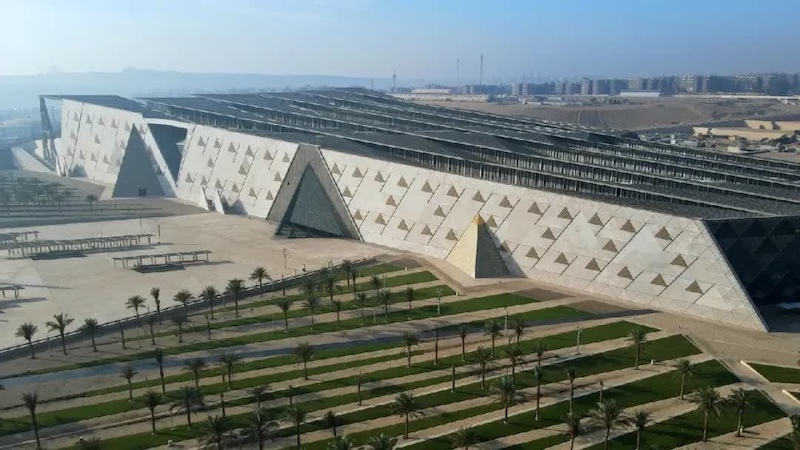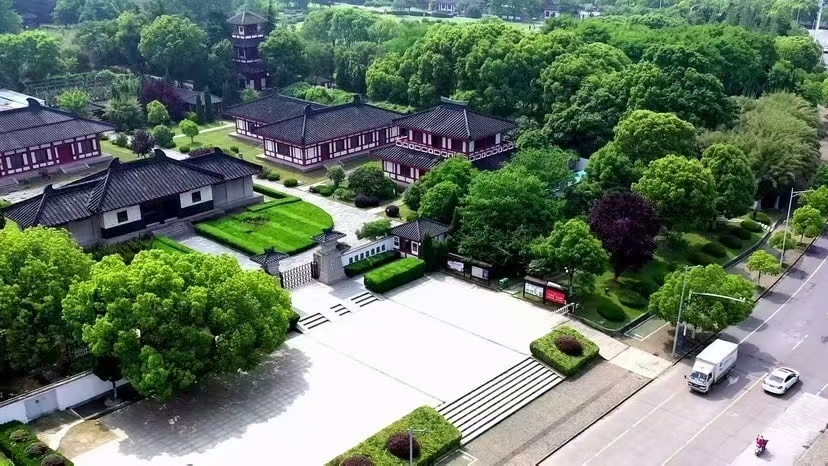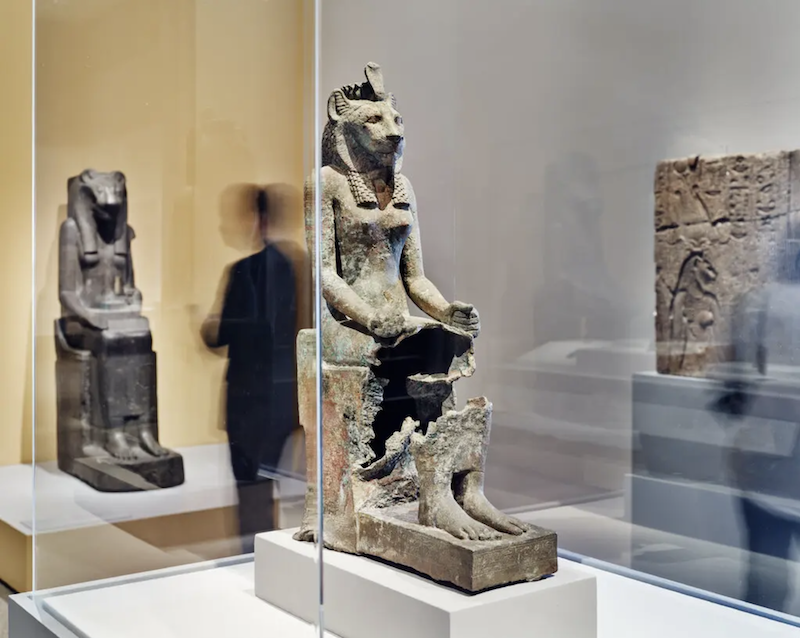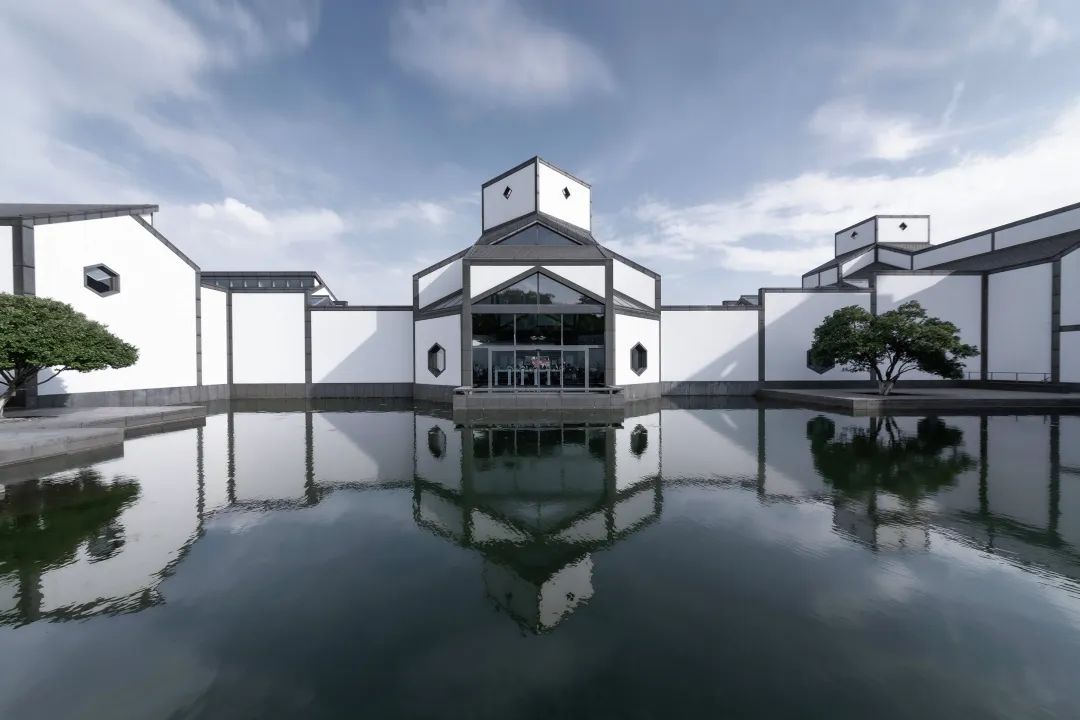
In twenty years, how did a building become a nationally renowned cultural landmark, and how did a museum grow into a bridge connecting Jiangnan with the world?
Next year, the Suzhou Museum will celebrate its 20th anniversary. Designed by renowned architect I.M. Pei, this modern garden-style museum has, since its inception, carried the mission of conveying the cultural heritage of Jiangnan and integrating Eastern and Western perspectives. The Paper recently interviewed Suzhou Museum Director Xie Xiaoting, reflecting on the museum's journey from its former "architectural phenomenon" to its current "cultural phenomenon."
The construction of Suzhou Museum began in 1960. Its original site was located in the Prince Zhong Mansion of the Taiping Heavenly Kingdom. Designed by the architectural master I.M. Pei, the museum was completed and opened in October 2006. It adheres to the concept of "Chinese and new, Suzhou and new" and the principle of "not too high, not too big, not too prominent", combining modern design language with the traditional architectural aesthetics of Suzhou, becoming a phenomenal new building of the year.

The Suzhou Museum is located next to the Humble Administrator's Garden in the ancient city of Suzhou.
Since 2012, the Suzhou Museum has successfully organized a series of special exhibitions titled "The Four Masters of Wumen" (2012-2015), featuring large-scale exhibitions of works by Suzhou-born painters Shen Zhou, Wen Zhengming, Tang Yin, and Qiu Ying. Each exhibition has become a major annual event for the calligraphy and painting community. The "Qing Dynasty Suzhou Collectors" series of academic exhibitions, launched in 2016, followed by the opening of the Suzhou Museum's West Building in 2021, and the annual special exhibitions "From the Humble Administrator's Garden to the 'Changwuzhi'" and "From the Humble Administrator's Garden to Monet's Garden" launched in 2025, have all had a lasting and far-reaching impact.
Over the past few years, the Suzhou Museum has become one of the leading institutions in China's cultural and museum landscape, a phenomenon in its architecture, exhibitions, scholarship, and cultural creativity. Embracing its mission of "Standing in Jiangnan, Observing the World," the museum has continuously developed an exhibition system that combines local depth with an international perspective.

Xie Xiaoting, Director of Suzhou Museum
Suzhou's cultural heritage and its positioning as "standing in the south of the Yangtze River and viewing the world"
The Paper: The Suzhou Museum’s exhibition “From the Humble Administrator’s Garden to Monet’s Garden” presents a dialogue between Eastern and Western garden culture. I would like to ask you to talk about the background of this exhibition and the Suzhou Museum’s positioning and ideas in exhibition planning in recent years.
Xie Xiaoting: Suzhou Museum's slogan is "Standing in Jiangnan, Viewing the World." We hope to structure the museum's exhibition system through these two distinct positionings. We aim to create a space for cultural exchange and mutual learning through the comparison of Eastern and Western artifacts.
For example, this garden exhibition is actually dedicated to the classical gardens of Suzhou. The exhibition hall lists nine criteria for outstanding universal value that qualify for World Cultural Heritage designation. Meeting just one is enough, but the classical gardens of Suzhou meet eight, a rare feat among World Cultural Heritage sites.

Exhibition site of "From Humble Administrator's Garden to Monet's Garden" at the Suzhou Museum

Monet's "Water Lily Pond" is currently on display at the Suzhou Museum.
But while deconstructing Chinese and Western gardens, we also very concretely displayed the exhibition "From the Humble Administrator's Garden to the Records of Superfluous Things" at the Suzhou Museum. We wanted to use a large macro and a relatively micro concrete case to let the audience feel, first, the beauty of Suzhou's classical gardens, and second, the exquisite life of the Ming Dynasty or the Suzhou literati of the Ming Dynasty.
When Wen Zhenheng wrote his "Records of Superfluous Things," a contemporary painter wrote the preface. He asked Wen Zhenheng, "Your family owns so many gardens in Suzhou, why did you write a book?" Wen Zhenheng's answer perfectly aligns with what we want to convey to our audiences through our current exhibitions: he described himself as experiencing the best of the literati life of the time, and he wanted to perpetuate that aesthetic standard. These exhibitions are also intended to better convey the aesthetics and civilization of this literati, as well as the cultural heritage of Suzhou.
Just like we're sitting here talking, this is the Wisteria Garden designed by I.M. Pei. It was because of the wisteria planted by Wen Zhengming when he designed the Humble Administrator's Garden that Mr. Pei wanted to graft a wisteria into the new pavilion, hoping to convey the cultural heritage of Suzhou.

Wen Zhenheng's "Changwuzhi" is on display at the Suzhou Museum. It is a late Ming Dynasty edition and is collected by Ningbo Tianyi Pavilion Museum.
The Paper: Do you think there are any innovations and creativity in this special exhibition “From Humble Administrator’s Garden to Monet”?
Xie Xiaoting: I actually think this exhibition is a bit more complex to put together than previous ones. This is because it was previously held at the Palace Museum, and now it's heading to Ningbo, with Suzhou in between, but the exhibition halls are different. While the Palace Museum emphasized palace culture, the Suzhou exhibition will focus more on connecting with local culture, specifically the culture of Suzhou gardens. It won't be a single exhibition; it could be three or four. But clearly showcasing Suzhou's unique characteristics across these three or four exhibitions is a challenge.
The Paper: What are your considerations when selecting exhibits?
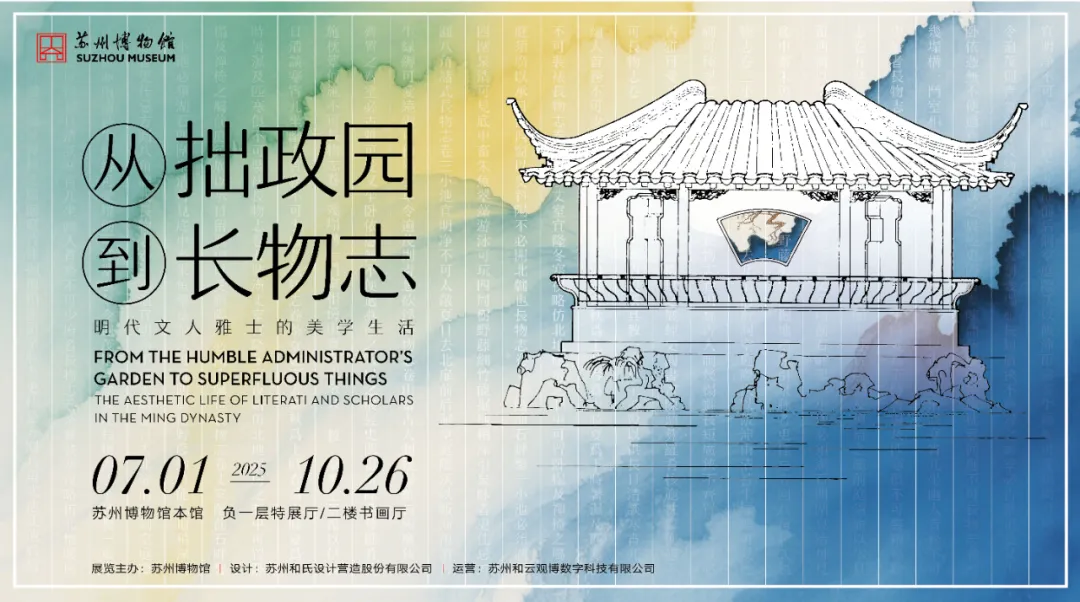
"From the Humble Administrator's Garden to the Stories of Superfluous Things" exhibition poster
Xie Xiaoting: My initial thought was to begin with the question, "Why gardens?" So, I initially explored the literati spirit of the Wei, Jin, Southern and Northern Dynasties, transitioned to the specific case of the Humble Administrator's Garden, and then moved on to examples of cultural exchange and mutual learning between China and the West, such as the Old Summer Palace, before moving on to Western gardens and finally to Monet's garden. The two major exhibitions, "From the Humble Administrator's Garden to the 'Changwuzhi'" and "From the Humble Administrator's Garden to Monet's Garden," are now on view in the Main Museum and the West Wing. One examines a specific case, the other a macro perspective. If you have the time, I hope you'll enjoy viewing both exhibitions together. This will allow you to gain a deeper understanding of Jiangnan culture and traditional Chinese culture.
Our "Modern Masters" series is still ongoing. The first featured Zhang Taiyan, the second Li Genyuan, this year's He Cheng (He Yanong), and next year's Liu Yazi. We have a logical progression: by the end of next year, we'll have completed the entire trilogy of Jiangnan culture. From "The Four Masters of Wumen" in 2012, to "Qing Dynasty Collectors," and finally to "Modern Masters," the Suzhou Museum has spent over a decade and twelve exhibitions covering 500 years of Suzhou. This extensive coverage of Suzhou's 500-year cultural development, the transmission and evolution of art, is truly remarkable.
Talking about the big cultural background from a personal perspective
The Paper: I always feel that the Suzhou Museum exhibition has a lot of materials to present and there is a lot of room for selection.
Xie Xiaoting: Yes, so we always use individuals to explain the broader context. For example, when we talk about the "Four Masters of Wumen," we don't just discuss their achievements in painting, but also explore the social, economic, and garden aspects of the Ming Dynasty. In 2013, we actually held a monthly lecture covering various aspects. When we talked about Qing Dynasty collectors, we used the stories of their collections to illustrate the economic development of Qing Dynasty society.
Suzhou Museum is, after all, a comprehensive museum in Suzhou. Its most important responsibility is to convey Suzhou's history and culture, or rather, to convey the history and culture of the Jiangnan region, as exemplified by Suzhou. These exhibitions also bear witness to the growth of a generation of Suzhou Museum staff. Looking back at the "Four Masters of Wumen" exhibition series from 2012 and 2013, the curatorial team from that time includes some who are now directors or deputy directors, some who have studied in the United States as postdoctoral fellows, and some who have already established themselves in the Chinese cultural and museum landscape. Over the past decade or so, not only has Suzhou Museum grown, but so has the curatorial team.
I majored in modern and contemporary history, but my first project was "The Four Masters of Wumen." Starting out really required constant learning. I still remember seeing a painting by Shen Zhou inscribed with a commentary about a trip he and his friends went to the Western Hills to see bayberries. After tasting just one, he recalled Wen Zhengming's dislike of bayberries due to his poor teeth. He also enjoyed drinking Yangxian tea from Yixing, brewed with Huishan Spring water from Wuxi. He may have been nearsighted, but he could still write tiny calligraphy in his eighties. Without a detailed exhibition, it's impossible to know.

2013 Su Bowen Zhengming Special Exhibition, Oxford University Art History Professor Craig Clunas (left) and Xie Xiaoting
The reason why I like working in a museum is that it allows you to learn continuously. You will find that you have many weaknesses that need to be improved, and gradually, your knowledge and experience will also grow.
The Paper : We just mentioned that Wen Zhengming had bad teeth. It feels like this ancient person is no longer cold and lifelike, but very vivid in front of you.
Xie Xiaoting: Yes. When we were working on the Tang Bohu exhibition, we were keen to convey to the audience that Tang Bohu wasn't a comic figure, but a tragic one. When developing the cultural and creative elements for the "Tang Bohu Special Exhibition," we created a special cultural and creative product called "Tang Yin Bubble." We developed four teas, hoping to allow you to experience Tang Yin's life over the course of a cup of tea. We inscribed Tang Yin's most important milestones on the tea bags, allowing the audience to experience Tang Yin's life through a cup of tea. For the Wen Zhengming exhibition, we also created a cultural and creative product featuring Wen Zhengming's hand-planted wisteria seeds.
The Paper: It is said that your Wen Zhengming hand-planted vine cultural products are selling very well.

The vines planted by Wen Zhengming in the Suzhou Museum gardens

Wen Zhengming's Hand-Planted Vine Cultural and Creative Products
Xie Xiaoting: The idea for this product, which was then described by the People's Daily as having the most potential, originated from right here where we're chatting. I was chatting with the director of the Tokyo National Museum in Japan when I looked up and saw wisteria pods forming. The director told us we could pick the seeds, as wisteria grows easily. Replanting the seeds felt like a way to pass on cultural heritage. We were planning an exhibition about Wen Zhengming at the time, and we were considering opening gifts that wouldn't be too expensive but still had meaning. So, we packaged three wisteria seeds as gifts. We've seen so many visitors tell us their wisteria pods have sprouted, grown taller, or even produced the next generation. This cultural product effectively connects visitors to the museum, and it's an irreplaceable emotional connection.
The Paper : Can you tell us, for example, how much the seeds of Wen Zhengming’s hand-planted vines can sell for in a year?
Xie Xiaoting: It is not the product that costs the most money we sell. In a good year, we sell about a thousand boxes of seeds. In a bad year, we sell about 700-800 boxes. Each box costs 38 yuan, so you can calculate how much we sell each year.
I.M. Pei left behind more than just a building
The Paper: I remember that when Mr. Pei first designed the Suzhou Museum more than 20 years ago, there was actually some controversy.
Xie Xiaoting: Mr. I.M. Pei left more than just a building to his hometown. First of all, he made the museum building itself an exhibit, a concept that was not available in the Chinese museum community at that time.
Furthermore, at the time, museum exhibition halls were often very dark, intended to highlight the artifacts. The second concept that Mr. Pei changed in the Chinese museum community was the idea that museums should have light. Mr. Pei's inspiration for our generation of museum workers is that it's more important to strive for perfection in our work.

If you look at the architecture of the Suzhou Museum, you'll discover Mr. Pei's meticulous attention to detail. Every line is perfectly aligned. For example, the line of the door aligns with the floor tiles below, and with the beams and planters above—everything aligns perfectly. He demanded such meticulous attention from the construction team, which was incredibly difficult. Looking back 20 years later at his architecture, his designs, and the countless efforts he made to realize them, is truly worth revisiting.
Mr. I.M. Pei has passed away. We now treat this building like a national treasure and maintain it. This is what the museum will do next.

Mr. I.M. Pei at the Suzhou Museum

Suzhou Museum Main Building
Next year marks the 20th anniversary of the Suzhou Museum. We initially plan to bring together all the museums designed by I.M. Pei to form an alliance of museums designed by him, including the Louvre in France, the Historical Museum in Berlin, Germany, the Miho Museum in Japan, and the Qatar Museums. We will launch this alliance at the 20th anniversary celebration. Finally, I'd like to jointly nominate these museums designed by Pei for World Cultural Heritage status.
Suzhou Museum no longer has a peak or off-season
The Paper: During the summer vacation, we did a special project focusing on the difficulty of making reservations at museums. Of the two Suzhou Museums, making reservations at this museum is the most difficult. How does Suzhou Museum deal with this?
Xie Xiaoting: The opening of the West Wing has alleviated some of the pressure on the museum. We've also designed a Discovery Experience Hall specifically for young people aged 3-12. Building on this, we're developing a "museum school" concept. We aim to cater to all ages, all demographics, and all interests. Consequently, Suzhou Museum currently hosts over 3,000 educational events annually across its two branches. We hope these activities will reach every demographic.

Suzhou Museum West Building
The West Building is currently appointment-free, so why does our museum require reservations now? Because the space is so small, and there are so many people wanting to come, we still need to control the flow of people. The West Building is larger, and we hope more people will visit it.
The peak number of visitors to Suzhou Museum in 2018 was 3.18 million. During holidays, visitors would walk around the Suzhou Museum. If they wanted to queue, they had to go to the back door of the Humble Administrator's Garden. The space in this area was limited, so the reservation system was later adopted.
Now the Suzhou Museum has no peak or off-peak seasons. It is fully booked every day. In the peak season, tickets are sold out within five minutes of being released, while in the off-season, tickets are booked two or three days in advance.
The Paper: And over the past few summer vacations, especially in the past five or six years, cultural and museum activities have been particularly popular. Do you feel that there is something different about the audience?
Xie Xiaoting: I think our audience is also evolving. I've always said that our audience is actually now version 2.0. More than a decade ago, the majority of visitors were middle-aged and elderly, but over the past decade, you've found that young people are the main force of museum visitors, and their knowledge base has significantly improved. To cope with this iterative audience, museum staff must constantly update their own knowledge base.
A place where people can come home
The Paper: For a museum, collections are quite important. Suzhou Museum is not only oriented towards the ancient times, but also towards the future. How will the structure of your collections prepare you for the next few decades or centuries?
Xie Xiaoting: I've always said that the Suzhou Museum was a very poor museum, with a collection of over 25,000 pieces. Of course, various historical reasons led to the museum's small collection. However, the Suzhou Cultural Relics Appraisal and Evaluation Center has been fully integrated into the museum, and their collection has become part of the Suzhou Museum's collection. The museum has suddenly transformed from a "poor" institution into a "rich" institution. After two years of transfers and handovers, the museum's collection is likely to reach over 200,000 pieces. We are planning exhibitions based on these collections as we hand them over. We may update our basic displays next year. At the same time, we will also leverage the collections from these cultural relics stores to plan more original exhibitions, further promoting the globalization of Chinese culture.
The Paper: Regarding the Suzhou Museum, there is also a feeling that it seems to be a place where people can feel at home.
Xie Xiaoting: I hope that when visitors come to Suzhou Museum, they will feel that it is a warm museum. When they look back on their experience of visiting here several years later, they will definitely feel warm and affectionate.
The Paper: Suzhou’s current museum and art gallery ecosystem is quite interesting, and may be the highest quality among China’s prefecture-level cities. What do you think of Suzhou’s current art and exhibition ecosystem?
Xie Xiaoting: When I talk about cultural diversity, I don't think that the Suzhou Museum alone is the only one that stands out. I hope visitors can see more museums and experience the 2,500-year history and culture of Suzhou. Suzhou currently has 127 museums and art galleries. We hope that Suzhou's cultural and museum communities will provide a diverse range of cultural offerings and services, so that visitors can experience a variety of exhibitions during their visit.
In fact, Suzhou Museum is definitely not able to achieve a grand narrative like the National Museum and the Palace Museum. You see, we never hold "Exhibition of Ancient Chinese Jade" or "Exhibition of Ancient Chinese Gold". Each museum should plan according to its own positioning. We are "standing in Jiangnan and viewing the world". We are inheriting Jiangnan culture and exchanging and learning between Chinese and Western cultures. Looking at the website, the cultural and creative products of Suzhou Museum are different from those of the Palace Museum. The cultural and creative products of Suzhou Museum must be graceful.
